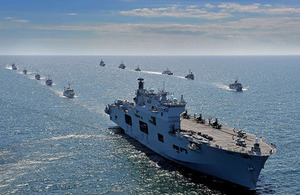2017 is the Year of the Navy
2017 is set to be the year of the Royal Navy as it prepares to welcome new ships to the fleet, following one of their busiest years since the end of the Cold War.

The Helicopter Carrier HMS Ocean during Exercise BALTOPS 2015. She has AH1D Apache Attack, and Wildcat helicopters on her flight deck and has ships from the 17 partner nations that took part in the exercise following behind.
Defence Secretary Sir Michael Fallon has paid tribute to thousands of personnel involved in the wide range of key tasks that the Navy has been engaged with in 2016. This includes responding to Russian activity in the North Sea, English Channel and North Atlantic, supporting EU and NATO-led operations in the Mediterranean and Aegean, helping safeguard our overseas territories, and taking the fight to Daesh by leading a US Navy task force in the Gulf.
Defence Secretary Sir Michael Fallon said:
We are investing billions in growing the Royal Navy for the first time in a generation with new aircraft carriers, submarines, frigates, patrol vessels and aircraft all on their way. 2017 is the start of a new era of maritime power, projecting Britain’s influence globally and delivering security at home.
At the peak of activity in 2016, Naval service personnel were involved in 22 operations at home and abroad, serving on nearly 30 ships, submarines, support vessels and Fleet Air Arm squadrons – 8,325 sailors and Royal Marines in all. This pace of operations will continue throughout the festive period and well into 2017 – during the first quarter of next year, one third of the Royal Navy’s front-line strength will be on global operations.
As well as these missions, led by the maiden voyage of Britain’s biggest ever warship, the aircraft carrier HMS Queen Elizabeth, a raft of new ships will either commence build, be launched or be delivered to the fleet as part plans to expand the size and strength of the Royal Navy to meet its growing commitments around the world.
Key milestones in 2017 include:
-
HMS Queen Elizabeth, will sail from Rosyth, ready to conduct sea trials in summer and debut in Portsmouth later in the year;
-
Her younger sister HMS Prince of Wales will enter the water for the first time in the summer as work on her continues and is due to be formally named in the autumn;
-
Design and Manufacture will begin on the multi-million pound Crowsnest, the early-warning ‘eyes in the sky’ system for the helicopters that will protect the new carriers;
-
In the summer, steel will be cut on the first of eight Type 26 frigates in Glasgow;
-
The first of four Tide-class tankers, RFA Tidespring – crucial for supporting the new aircraft carriers – will arrive from South Korea in the spring to undergo UK customisation work;
-
Similarly, in the spring, the first of the Navy’s five next-generation patrol ships, HMS Forth will begin her sea trials;
-
The fourth Astute Class submarine will enter the water for its commissioning phase in spring;
-
The keel for the seventh and final Astute-class submarine – as yet unnamed – will be laid in 2017 as work continues apace on the fifth and sixth, HMS Anson and HMS Agamemnon in Barrow;
-
The opening of the first permanent Royal Navy base East of Suez in nearly half a century.
On the operational front:
-
Vanguard-class submarines will carry out the 48th year of continually providing our at-sea nuclear deterrent;
-
HMS Ocean will continue to lead the US Navy’s carrier task group in the Gulf until February, supported by Type 45 destroyer HMS Daring providing air defence;
-
Royal Marines and the Commando Helicopter Force will carry out three months of winter training in Norway to protect NATO’s northern flank;
-
40 Commando Group, based near Taunton, will assume the responsibility of on-call Royal Marines unit from May;
-
and numerous frigates, Minehunters survey and patrol ships of the Royal Navy and support ships of the Royal Fleet Auxiliary will continue to protect UK interests in the Baltic, Gulf, Indian Ocean, Mediterranean, Caribbean, North and South Atlantic.